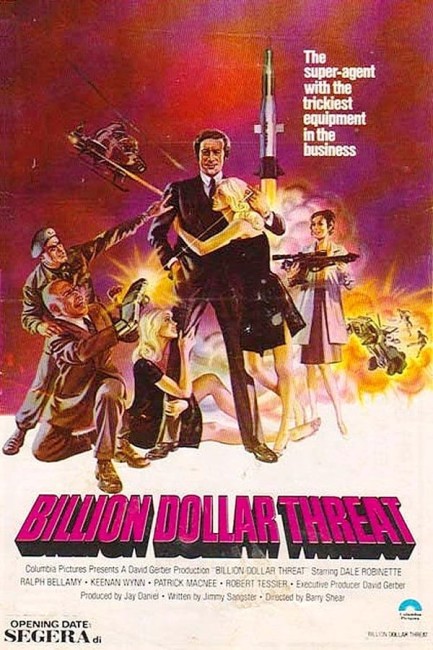Crew
Director – Barry Shear, Screenplay – Jimmy Sangster, Producer – Jay Daniel, Photography – Jack Woolf, Music – Richard Shores, Art Direction – Ross Bellah & Dale Hennesy. Production Company – David Gerber Productions.
Cast
Dale Robinette (Robert Sands), Patrick MacNee (Horatio Black), Ralph Bellamy (Mike Larson), Ronnie Carol (Marcia Buttercup), William Bryant (Harry Grebe), Keenan Wynn (Ely), Beth & Karen Specht (Holly & Ivy)
Plot
Secret agent Robert Sands is sent to investigate a series of UFO sightings in the Utah desert. During the course of his investigation, Sands discovers that what are thought to be UFOs are in fact reflector shields being airlifted as part of a device built by criminal mastermind Horatio Black. Sands uncovers Black’s scheme to burn a hole in the ozone layer, which will crisp all beneath it as it circles the Earth, unless the governments of the world pay him a billion dollars.
In turning out the screenplays for Hammer’s The Curse of Frankenstein (1957) and Dracula/The Horror of Dracula (1958), Jimmy Sangster helped shape the entire British horror industry for two decades. In the 1960s, Sangster worked on Hammer’s various monster sequels and psycho-thrillers but his star began to dim after he took up the director’s chair with the puerile likes of The Horror of Frankenstein (1970) and Lust for a Vampire (1971). After the Anglo-horror cycle began to wane in the mid-1970s, Sangster moved into writing for US tv where he was reduced to churning out tawdry tv movie thrillers like The Concrete Cowboys (1979), Murder in Music City (1979) and No Place to Hide (1981) and spy movie copies such as Once Upon a Spy (1980) and this.
Billion Dollar Threat was a pilot for a tv series that was clearly attempting to replicate the success of the James Bond films on the small screen. The tv series never ended up being made but Billion Dollar Threat did receive cinema release in some parts of the world. It features all the hallmarks of a made-for-tv movie – the credits come tv-styled with each of the players being introduced with their names and photos and others listed as special guest stars. The action is minimalised and padded-out, designed to be cut around commercial breaks. The gimmickry, introduced in a blatantly Bond-derivative Q sequence, is feebly short in both imagination and budget. The commercial breaks – where the action builds to a climax and the camera fades to black before the action resumes – have even been left in in the cinematic print, which shows how little people cared.
The film’s one moment of imagination is the villain’s world domination scheme of demanding a ransom from the nations of the world by threatening to burn a hole in the ozone layer and letting it circle the Earth and scorch everything beneath it. There is something wildly plausible to it – it is a scheme that you could imagine someone actually trying. While this might have seemed far-fetched in the 1970s, it has become even more relevant in the eco-conscious 90s with the emergence of real fears about ozone layer holes. The one flaw in the villain’s scheme is to assume that a hole in the ozone layer would circle the world, not unakin to the Moon’s orbit – sadly to report, the ozone layer is geo-stationary ie. it would not circle but would only remain over the spot where it was created.


